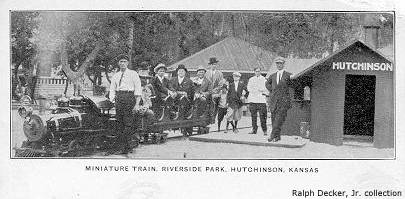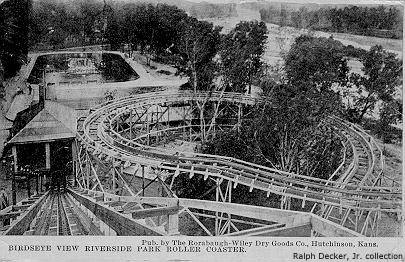Riverside Park
Hutchinson, Reno County, KS
by Ralph Decker, Jr.
| Date Opened: 1888 Date Closed: 1930s Location: south end of Main Street Remains at site: No remnants of the rides exist. The land is now part of Carey Park, a city park with no amusements. A zoo does exist in Carey Park, but it is not in the area that was Riverside Park and it is unclear if it is a direct descendant of that operation. Trolley Park: Yes |

| Beginnings While Riverside Park seems to have existed prior to 1888, it is in that year that its first use other than as a "green" space seems to have occurred. Fred Fosha operated a zoological garden and displayed a large variety of animals. Emerson Carey assumed operation of the grounds in 1897. Under his auspices circuses were brought to the park. Additionally, musicals and stage plays were presented in the Riverside Park Auditorium, a large wooden structure, until it was moved to the Kansas State Fairgrounds in 1901. Also, at this time, a few rides were added. By 1902 Konrad C. "Koon" Beck was manager of the park. Born in Iowa, he had moved to nearby Nickerson, Kansas, at an early age. He dropped out of school at age fourteen and became an expert hunter and trapper. He established K. C. Beck’s Sportsman’s Show and traveled to county fairs throughout Kansas to display his menagerie. Riverside Park became the winter home to the collection. A group of local businessmen, who were also stockholders in the local traction company, persuaded him to improve the park as a way to increase streetcar ridership. In 1908 Beck and his associates leased the park for five years. In 1913 he purchased the land, built the Airdome outdoor theater and a house for himself and his family just to the east of the entrance. Beck’s business was the animals. He had contacts with trappers and hunters around the world. Some of the wildlife came to Hutchinson, but Beck also supplied animals to the Bronx Zoo (New York), Lincoln Park Zoo (Chicago), and the Zoological Gardens (Hamburg, Germany). His main interest in Hutchinson was that of a waterfowl preserve. More than one thousand birds lived at a lagoon built for that purpose. But Beck was also a showman and it was under his guidance that Riverside Park became known as the Coney Island of the Midwest. |
|
Rides and attractions
|
 |
| No description or pictures of the "water ride"
seem to exist. However, one must assume that it was a "tunnel of love" as there
are references to "grabbing your girl" and "taking a sip from a hip-pocket
flask." The train engineers are listed as Oren Ashby and Bill Dixon. The "Circle Dip" roller coaster opened July 23, 1910. H. L. Breinig of Terre Haute, Indiana, was the "constructor" with Rolo Loomis being the superintendent. It is noted that the Circle Dip was Loomis’ seventeenth coaster of 1910 as he had supervised construction of similar amusements in Denver, Milwaukee, Memphis, and Trenton as well as other locations. A newspaper account of the day reports the track to have been 19,037 feet in length, but one has to assume such was a typographical error as the highest hill is listed as twenty-two feet. The coaster boasted six cars, which could be started one minute apart. One of the cars was named the K. C. Special and the other five were named to honor neighboring towns. On opening night the mayor of Hutchinson and other dignitaries took the first ride. Local groups chartered another car for the entire evening. In addition to the many species of birds at the waterfowl lagoon, the zoo included African lions, mountain lions, a Tasmanian devil and an African rantel. An elephant and a chimpanzee, Hip and Napoleon, were not only part of the zoo, but performed in the park as well. Ostriches roamed the park, constantly begging for popcorn. Drama and vaudeville were presented at Riverside. The Wallace Bruce Players, The Marx Brothers, the York and King dance team, and burlesque shows regularly played the park. However, the follies, featuring such names as The Bell Boy Troop and Milton Schuster’s were the most popular. Hutchinson has long been home to the Kansas State Fair and Beck looked upon that event as a challenge. At first he put on a spectacular fireworks show during the run of the fair. However, the more the fair board objected, the more ingenious Beck became in advertising his park. First he had a cage of monkeys pulled up and down Main Street by a team of Shetland Ponies driven by a park employee. Banners on the cage advertised the park. Later he became so bold as to put a cage of lions on the back of a truck, put seats for some of the follies girls on top of it, and have it driven onto the fairgrounds! The ministers of the area were not particularly happy to have Riverside Park in the area. The "girlie" shows, the games of chance, the rumor that liquor was sold at the cabaret, and the fact that the big day at the park was Sunday all increased the hostility between Beck and the pastors. A "lingerie contest" brought the situation to the boiling point. The local chief of police threatened to arrest anyone who worked in the park on Sunday. However, by that time Beck was the sheriff of Reno County. On the appointed Sunday he arrested the park employees, but by Monday he had decided not to press charges.
|
|
Remains The depression and the automobile brought an end to the lights and laughter at the south end of Main Street. There are no physical remains of the rides, buildings, or the waterfowl lagoon that once comprised Riverside Park. When the amusements closed, The City of Hutchinson purchased the land and it was added to Carey Park, which was originally south and east of Riverside. Koon Beck was elected City Marshall in 1942.
|
|
Resources &
References
|
|
All material on this page was provided
courtesy of Ralph Decker.
Thanks to him for allowing defunctparks.com to use this material.
© 1998 Joel W Styer. All rights
reserved. Updated Wednesday, February 18, 2004